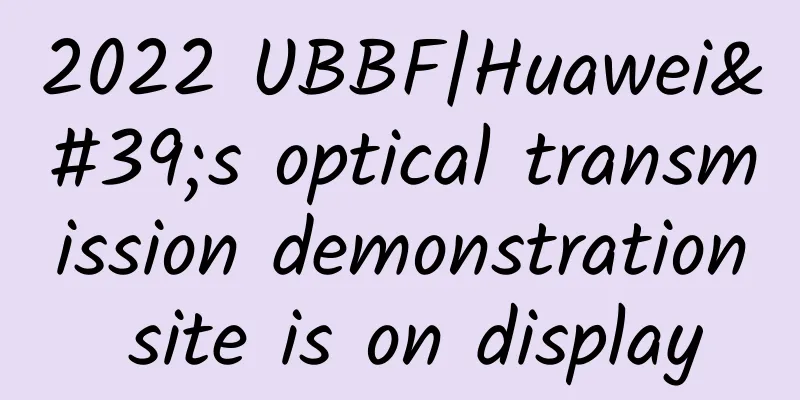2022 UBBF|Huawei's optical transmission demonstration site is on display

|
[Bangkok, Thailand, October 28, 2022] From October 24 to 28, 2022, the UBBF Global Ultra-Broadband Summit was held in Bangkok, Thailand. Among them, Huawei's optical transmission field model site exhibited a number of "black technologies", demonstrating innovative business logic ideas and technical practice examples for global operators. As the global digital development process deepens, optical dedicated line services are more widely used in various industry scenarios, such as bank VTM remote customer service guiding account opening procedures, medical cloud support for doctors to browse patient reports on the cloud, and space travel at home through cloud rendering services. Optical dedicated lines with large bandwidth, low latency, and high reliability have gradually set off a development trend and become the standard for commercial scenarios. Figure 1: Operator customers experience video cloud rendering dedicated line service Although the development of private line services in various parts of the world varies, when faced with the demand for optical private lines, how to effectively monetize OTN private lines has always been a concern for global operators. In response, Huawei has effectively improved the intelligence level of optical networks through the capability innovation of iMaster NCE, providing key enablement for the monetization of private line services. As the core of the OTN network management and control system, Huawei iMaster NCE provides operators with capabilities that fit the entire service life cycle for realizing the commercial value of private lines. It not only has basic service delivery and alarm monitoring functions, but also supports sales through the ACTN northbound interface, helping operators improve efficiency and increase revenue. During the sales expansion phase, operators can quickly query the lowest latency of private lines through NCE's latency map to ensure that the network fully meets customers' latency and bandwidth requirements, greatly improving the efficiency of matching business needs. At the same time, through the online visualization and automatic recommendation of private line availability, operators can accurately help customers select high-reliability private lines that meet their needs. During the service provisioning phase, StellarGo's technical innovation not only allows customers to better match their SLA requirements, but also further improves the efficiency of OTN private line provisioning. This technology can achieve intelligent route selection from single factor, single strategy to multiple factors, multiple strategies based on expert experience and massive data training. At the same time, it can also provide personalized recommendations based on the SLA requirements of different customers. It has been verified that the route calculation success rate is as high as 99%, and the service provisioning efficiency is improved by 70%. With the help of better recommendation algorithms, customers can get higher quality private line services. During the service operation and maintenance phase, the dedicated line SLA guarantee capability can help operators monitor key service performance indicators in real time, and promptly identify and avoid service SLA risks. In the on-site demonstration, a Beijing-Shanghai dedicated line service (1,200 km apart) had a latency as low as 10ms. The customer said that the distance from Chiang Mai to Bangkok in Thailand is about 800 kilometers. Through the OTN optical dedicated line, the entire territory of Thailand can be included in the 10ms latency circle. In addition, Huawei's reliability commitment will also help operators realize the monetization of dedicated lines. By opening ASON at the network layer, intelligent incident management at the network management layer, and fault prediction, operators can quickly identify the root cause of the fault, locate the fault, and continue to provide VIP customers with highly reliable, zero-fault network services. Figure 2: On-site visit to experience new applications Huawei experts on site concluded that the digital development of various industries cannot be separated from the support of optical private lines and optical networks. Improving the automation and intelligent capabilities of operators will be the only way for future development. Huawei believes that through the concerted efforts of all parties and continuous practical exploration, the quality connection of optical networks will surely benefit thousands of industries and become an important support for the rapid development of the digital era! |
<<: Let’s talk seriously about what is a fiber optic terminal box?
>>: How to build supply chain finance modernization from Shengye
Recommend
Three-minute review! A quick overview of 5G industry development trends in May 2021
After the rapid development in 2020, 2021 is a cr...
Miao Wei: 5G and other communication infrastructure construction should be appropriately advanced
Miao Wei, deputy director of the Economic Committ...
Illustrated TCP three-way handshake: building a network session step by step
In Internet communications, ensuring the reliabil...
Five things you need to know about edge computing
As technology continues to advance, new models co...
Let's talk about 11 main neural network structures
With the rapid development of deep learning, a wh...
Tencent Cloud Light 1C2G3M is only 253 yuan (or 83 yuan/year) for three years, shared by new and old users
Tencent Cloud's Double 11 event is still vali...
5 Strategies for Monetizing Mobile Edge Computing (MEC)
In the past few years, cloud services have been u...
The third and fourth largest operators in the United States announced a merger. Can China Telecom and China Unicom follow suit?
On April 29, T-Mobile, the third largest telecom ...
Friendhosting 50% off promotion, VPS half-year payment starts from 7.5 euros
Friendhosting has launched a promotion for "...
5G issues should not be politicized
The official website of the European Competitive ...
How to replace the Query field in the URL?
[[420519]] When we write a crawler, we may need t...
TmhHost: 388 yuan/year KVM-2 cores, 4G memory, 40G disk, 1.5TB traffic, Los Angeles CN2 GIA/AS9929/Japan Softbank optional
This month, TmhHost continues to offer special an...
HostKvm newly launched Russia/Hong Kong high-defense VPS, 50% off for Mid-Autumn Festival
HostKvm has launched new products, this time with...
Kafka message sending thread and network communication
[[420379]] Let’s review the message sending seque...
Division of wireless AP channels in WLAN
What is a channel? Channel is commonly referred t...









